Stop Guessing, Start Forecasting: Elevate Your Sales Game
Tired of unpredictable sales figures? This list explores 10 powerful sales forecasting software solutions to help you accurately predict revenue, improve sales performance, and optimise operations. Discover key features, pros, cons, and pricing for each tool to find the perfect fit for your business. For UK-based TikTok Shop sellers, consider supplementing your chosen software with Mergoio for real-time profit tracking and cost forecasting, including upcoming Amazon integration.
1. Salesforce Sales Cloud
Salesforce Sales Cloud stands out as a leading CRM platform, particularly suited for data-driven businesses in the UK seeking advanced sales forecasting capabilities. It's more than just a CRM; it's a comprehensive solution that empowers your sales team to anticipate future performance and make informed decisions based on robust data analysis. For TikTok Shop sellers, eCommerce entrepreneurs, and digital marketing professionals operating in a fast-paced online environment, accurate forecasting is paramount. Salesforce Sales Cloud offers the tools to predict trends, optimise campaigns, and ultimately, boost profitability.
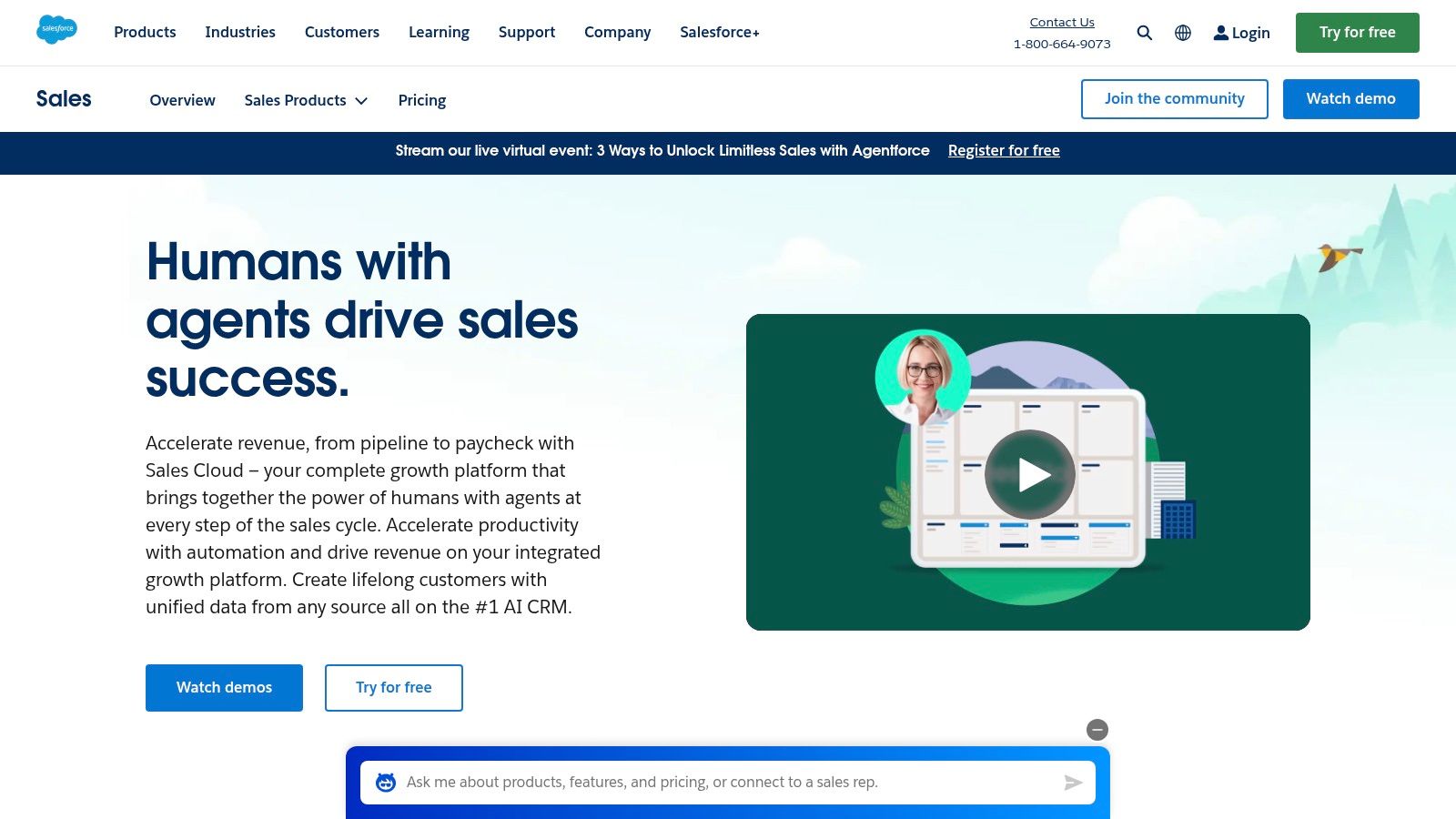
This platform deserves its place on this list due to its powerful AI-powered forecasting engine, Einstein Analytics. This tool analyses historical data, current pipeline information, and even individual sales rep input to generate highly accurate sales predictions. Imagine being a TikTok Shop seller and having the ability to forecast demand for a new product launch based on past campaign performance and current market trends. This predictive power allows you to optimise inventory, marketing spend, and staffing levels, leading to increased efficiency and profitability. Furthermore, Salesforce Sales Cloud allows for the creation of custom forecasting models tailored to the specific nuances of your business, whether you're a data-driven retailer or an early adoption beta tester. This flexibility makes it a valuable tool for businesses of all sizes and complexities in the UK market. You can learn more about Salesforce Sales Cloud and its features to see how it fits your specific business needs.
Features like real-time collaborative forecasting and pipeline management with confidence scoring add another layer of value. Real-time updates ensure everyone on the team, from sales reps to management, is working with the most current information. Confidence scoring helps prioritise leads and opportunities, allowing your sales team to focus their efforts where they're most likely to generate revenue. This is crucial for eCommerce entrepreneurs and digital marketing professionals looking to maximise their ROI. Moreover, mobile access allows for up-to-the-minute forecasting data, making it easily accessible for busy professionals on the go.
Pros:
- Seamless Integration: Integrates seamlessly with other Salesforce products, creating a unified ecosystem for managing all aspects of your business.
- Customisability: Highly customisable to meet the unique forecasting needs of your business, from custom hierarchies to tailored forecasting models.
- Robust Reporting: Offers robust reporting and dashboard capabilities for in-depth analysis and informed decision-making.
- Strong Support: Backed by a strong user community and extensive support resources, ensuring you have the help you need to get the most out of the platform.
Cons:
- Pricing: Higher price point compared to some other sales forecasting solutions.
- Initial Setup: Can be complex to set up and configure initially and may require a dedicated administrator, particularly for complex customisations.
- Additional Costs: Some advanced features may require additional purchases.
Pricing and Technical Requirements: While specific pricing is available upon request from Salesforce, it's important to note that Sales Cloud is a subscription-based service. Technical requirements are generally minimal, requiring a stable internet connection and a compatible web browser. However, integrations with other systems may require specific configurations.
Comparison with Similar Tools: While other CRM platforms offer forecasting capabilities, Salesforce Sales Cloud differentiates itself with the power of Einstein Analytics and its extensive customisation options. Solutions like HubSpot and Zoho CRM offer simpler forecasting tools, making them potentially more suitable for smaller businesses with less complex needs. However, for larger enterprises and those seeking advanced predictive analytics, Salesforce Sales Cloud offers a more comprehensive solution.
Implementation Tips: For a smooth implementation, consider starting with a clear understanding of your forecasting needs and objectives. Engage with Salesforce's implementation resources or certified partners to help configure the platform and train your team. Begin with a pilot program to test and refine your forecasting models before a full rollout.
2. InsightSquared
InsightSquared is a revenue intelligence platform geared towards providing robust sales forecasting and analytics, particularly beneficial for data-driven businesses operating at scale. It integrates with your existing CRM (like Salesforce) and other data sources to create a comprehensive view of your sales pipeline. This allows for AI-powered forecasts, detailed pipeline analysis, and automated activity capture, ultimately empowering sales leaders in the UK to make more informed decisions and improve revenue predictability. For TikTok Shop sellers, eCommerce entrepreneurs, and digital marketing professionals, this translates to a clearer understanding of sales trends and the ability to optimise campaigns for maximum ROI. Early adoption beta testers will appreciate the platform's advanced features and the ability to rigorously test and refine their sales strategies.
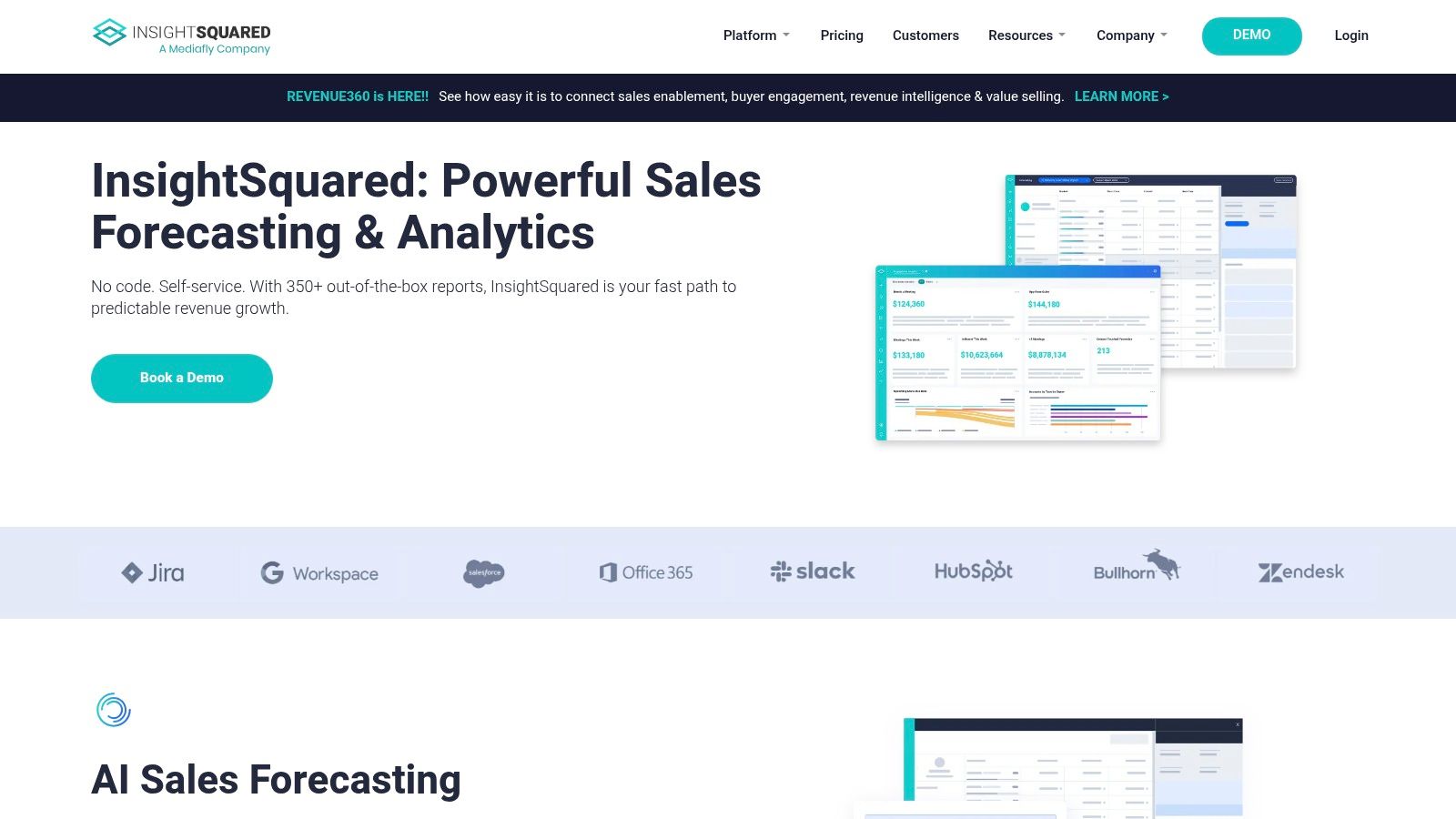
InsightSquared deserves its place on this list because it goes beyond basic forecasting. Its AI-driven insights provide a granular view of deal progression, potential roadblocks, and opportunities for improvement. For example, imagine a TikTok Shop seller launching a new product. InsightSquared can analyse historical sales data, current market trends, and campaign performance to predict sales for the new product, allowing for proactive inventory management and marketing adjustments. This level of predictive accuracy can be a game-changer for eCommerce businesses operating in the fast-paced TikTok landscape.
Specifically, features like bottoms-up and top-down forecasting methodologies offer flexible approaches to suit different business needs. Deal-by-deal forecast analysis provides deep insights into individual opportunities, enabling sales teams to identify and address potential issues early on. Historical forecast accuracy tracking allows you to monitor the platform's performance and refine your forecasting process over time. The interactive data visualisation dashboards provide a user-friendly way to understand complex data, making it accessible to all team members, even those without a technical background.
Pros:
- Deep CRM Integration: Seamlessly integrates with Salesforce and other leading CRMs, centralising your sales data.
- AI-Powered Analysis: Leverages artificial intelligence to deliver highly accurate forecasts and actionable insights.
- User-Friendly Interface: Intuitive dashboards and reports make it easy to understand and interpret data.
- Excellent Customer Support: Provides comprehensive support to help users get the most out of the platform.
Cons:
- Cost: Can be a significant investment, especially for smaller organizations or startups. Pricing information isn't publicly available, so contacting InsightSquared directly for a quote is recommended.
- Learning Curve: Some advanced features require a deeper understanding of sales analytics and the platform itself.
- Setup Time: Implementing InsightSquared can be time-consuming, requiring careful planning and data migration.
Implementation Tips:
- Clearly Define Objectives: Before implementation, outline your specific goals and how InsightSquared will help you achieve them.
- Data Cleansing: Ensure your CRM data is clean and accurate to maximize the platform's effectiveness.
- Team Training: Provide adequate training to your sales team to ensure they understand how to use the platform effectively.
Comparison: While other tools like Salesforce offer basic forecasting functionality, InsightSquared provides a more specialized and in-depth approach, ideal for data-driven sales teams.
Website: https://www.insightsquared.com/
By leveraging InsightSquared, businesses in the UK, particularly those operating on platforms like TikTok Shop, can gain a competitive edge by making data-backed decisions, optimizing sales processes, and achieving predictable revenue growth.
3. Anaplan
Anaplan is a robust enterprise planning platform specifically designed for large organizations with complex sales forecasting needs. Its sophisticated modelling capabilities and integrations with core business systems make it a powerful tool for data-driven decision making, although its enterprise focus might make it less suitable for smaller businesses.
Anaplan allows businesses to move beyond basic sales predictions and create dynamic, connected plans that incorporate sales, finance, and operational data. Imagine a TikTok Shop seller scaling rapidly – they could use Anaplan to forecast inventory needs based on projected sales, ensuring they always have the right products available to meet demand. Similarly, an eCommerce entrepreneur expanding into new markets could model various scenarios to understand the potential impact on revenue and resource allocation. Data-driven retailers can leverage its real-time, multi-dimensional forecasting models to optimise pricing strategies and promotions based on predicted demand fluctuations.
This platform's strength lies in its proprietary Hyperblock technology. This technology enables complex calculations, what-if analyses, and scenario planning, providing a level of detail and accuracy often lacking in simpler forecasting tools. For instance, a digital marketing professional could use Anaplan to model the impact of different campaign strategies on sales pipeline and revenue, allowing for data-backed optimisation.
Key features include:
- Real-time, multi-dimensional forecasting models: Gain instant insights into sales performance and potential future outcomes.
- Scenario planning and what-if analysis: Test different assumptions and strategies to understand their potential impact on sales.
- Role-based forecast views and permissions: Control access to sensitive data and ensure that each team member sees the information relevant to their role.
- Quota and territory management integration: Align sales targets with territories and track performance against quotas.
- Connected planning across departments: Break down silos and ensure that sales, finance, and operations are working from a shared set of data.
Pros:
- Highly scalable for enterprise organizations.
- Extremely flexible modeling capabilities.
- Strong integration with ERP and financial systems.
- Supports complex organizational structures.
Cons:
- Higher price point aimed at enterprise customers. While specific pricing isn't publicly available, it's geared towards larger businesses.
- Steeper learning curve than some alternatives.
- Implementation typically requires specialized consultants.
- Can be overly complex for smaller businesses. For example, a small eCommerce business operating solely through TikTok Shop might find its robust features excessive and its complexity overwhelming.
Implementation Tips:
Given Anaplan's complexity, consider these tips:
- Engage with Anaplan consultants: Leverage their expertise to ensure a smooth implementation process.
- Clearly define your requirements: Outline your specific forecasting needs and objectives.
- Invest in training: Ensure your team is adequately trained to utilise the platform effectively.
While Anaplan is a powerful tool, its complexity and cost make it best suited for large organizations with sophisticated forecasting needs. Smaller businesses or individual TikTok Shop sellers may find more streamlined and affordable alternatives better suited to their requirements. If you're curious to dive deeper into the complexities of Anaplan, learn more about Anaplan.
For those managing large teams, complex sales pipelines, and intricate business structures, Anaplan's comprehensive features and integration capabilities offer a compelling solution. Its strength lies in its ability to connect different parts of the business, providing a holistic view of sales performance and future projections. It deserves its place on this list due to its powerful modelling capabilities and focus on enterprise-level planning. However, smaller UK businesses should carefully weigh the cost and complexity against their actual needs before committing to this platform. Visit the Anaplan website for further details: https://www.anaplan.com/solutions/sales-forecasting/
4. Clari
Clari is a revenue operations platform that goes beyond basic sales forecasting by leveraging AI to provide highly accurate revenue projections. Unlike traditional methods that rely heavily on gut feeling and historical data, Clari analyses a wide range of data points, including CRM data, email communications, calendar events, and even meeting notes, to provide predictive insights into deal health and likely outcomes. This makes it particularly valuable for data-driven retailers, eCommerce entrepreneurs, and TikTok Shop sellers operating in the fast-paced world of online commerce, where accurate forecasting is critical for inventory management, marketing spend, and overall profitability.
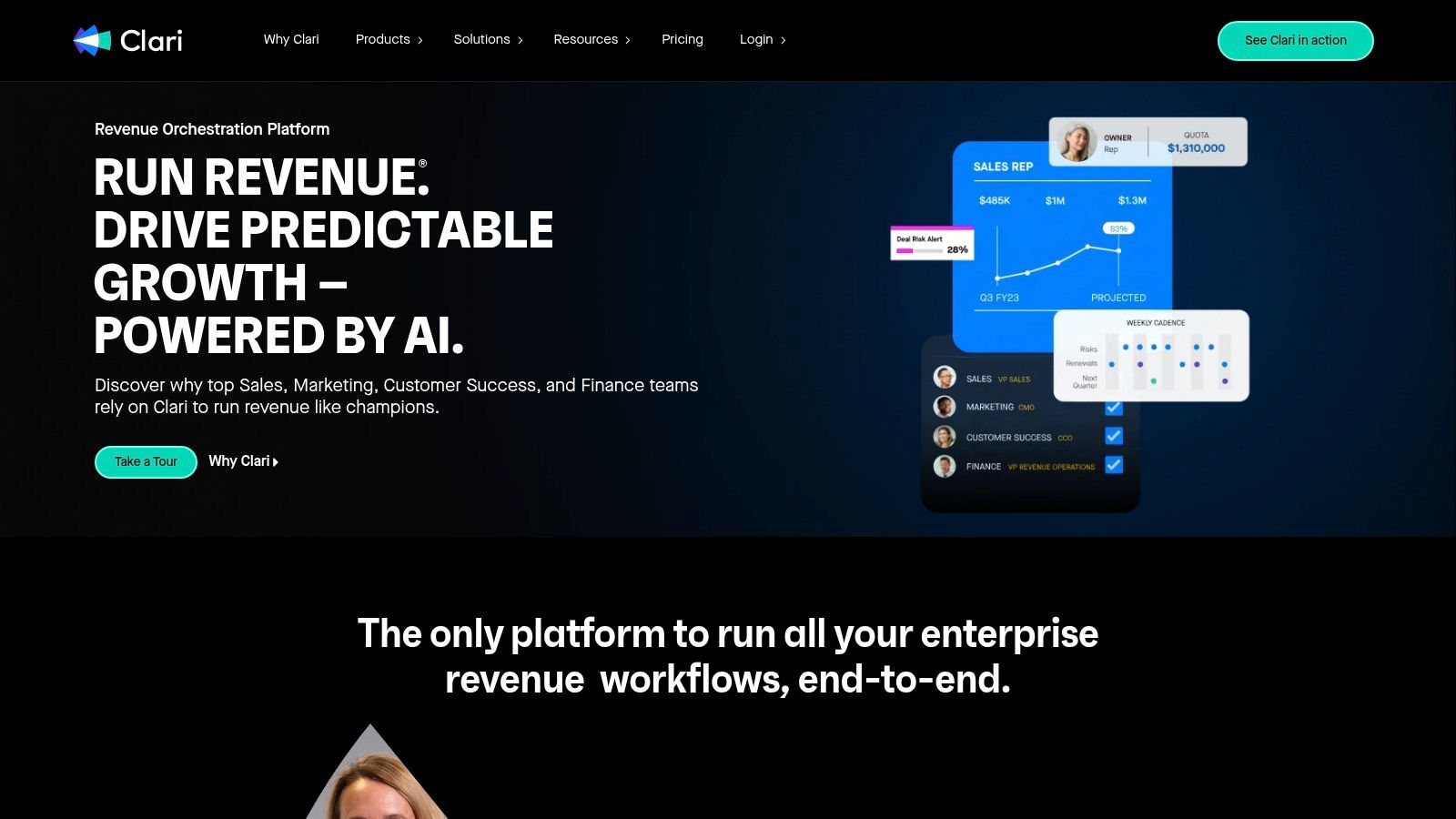
For example, a TikTok Shop seller using Clari could gain insights into the potential success of a new product launch by analysing pre-order data, engagement metrics from promotional videos, and even sentiment analysis from comments. This allows for more informed decisions about inventory levels, preventing stockouts or overstocking. Similarly, eCommerce entrepreneurs can use Clari to identify at-risk deals in their pipeline, allowing them to proactively address potential issues and improve conversion rates. The platform's time-series analysis of forecast changes also helps businesses understand trends and adjust their strategies accordingly.
Clari’s AI-driven opportunity scoring and risk assessment are especially useful for identifying high-potential opportunities and mitigating potential losses. Features like pipeline inspection with deal insights and activity intelligence from emails and meetings offer a granular view of sales activities, providing valuable context for decision-making. Automated data capture from various sources significantly reduces manual data entry, freeing up valuable time for sales teams and digital marketing professionals.
While pricing information isn't publicly available, it's worth noting that Clari's premium features and advanced AI capabilities position it at a higher price point, which might be a consideration for smaller teams or early-stage businesses. It's important to have good quality CRM data for optimal results, as Clari's accuracy relies on the data it analyses. Some advanced features may require additional configuration and integration with existing systems.
Key Features:
- AI-driven opportunity scoring and risk assessment
- Time-series analysis of forecast changes
- Activity intelligence from emails and meetings
- Pipeline inspection with deal insights
- Forecast submissions and rollups
- Automated data capture
Pros:
- Highly accurate AI predictions based on multiple data points
- Intuitive user interface designed for all levels
- Excellent mobile experience
Cons:
- Premium pricing may be prohibitive for smaller teams
- Requires good CRM data quality for optimal results
- Some advanced features may require additional configuration
Implementation Tips:
- Ensure your CRM data is clean and up-to-date before implementing Clari.
- Dedicate time for training and onboarding to maximise the platform's potential.
- Consider integrating Clari with other tools in your sales and marketing stack for a seamless workflow.
Clari earns its place on this list due to its sophisticated AI-powered forecasting capabilities, providing businesses with accurate and actionable insights for revenue optimization. While the price point may be higher than some alternatives, the potential return on investment, especially for data-driven businesses in the UK's competitive eCommerce landscape, makes it a strong contender. For businesses looking to move beyond basic forecasting and leverage the power of AI for revenue growth, Clari offers a compelling solution. You can explore Clari's features and request a demo on their website: https://www.clari.com/
5. NetSuite Planning and Budgeting
NetSuite Planning and Budgeting earns its spot on this list due to its robust integration with the wider NetSuite ecosystem, making it a powerful forecasting tool for existing NetSuite users, particularly larger businesses. While it offers sophisticated planning capabilities, it's essential to weigh its comprehensive features against its higher cost and complexity, especially for smaller businesses or those not already using NetSuite.
This solution goes beyond basic sales forecasting, providing a comprehensive platform for financial planning and budgeting. This is especially valuable for UK businesses looking to align sales projections with overall financial goals and resource allocation. For TikTok Shop sellers, eCommerce entrepreneurs, and data-driven retailers experiencing rapid growth, NetSuite's ability to handle complex forecasting models and large datasets can be a significant advantage.
Practical Applications & Use Cases:
- Product-Level Forecasting: Predict sales for individual products or product lines to optimise inventory management and marketing campaigns. For example, a TikTok Shop seller focusing on fast fashion can anticipate demand spikes for trending items and ensure sufficient stock.
- Customer Segmentation: Create targeted sales forecasts based on different customer demographics, purchase history, or behaviour. This allows businesses to tailor marketing efforts and personalise the customer experience.
- Regional Sales Analysis: Track sales performance and forecast future growth across various geographical regions within the UK. This is particularly relevant for eCommerce businesses expanding their reach across the country.
- Scenario Planning: Model various "what-if" scenarios, such as changes in marketing spend, pricing strategies, or economic conditions, to understand potential impacts on revenue. This is invaluable for navigating uncertainties like Brexit's lingering effects or fluctuating exchange rates.
- Driver-Based Forecasting: Identify and incorporate key business drivers, like website traffic, conversion rates, or social media engagement, into your forecasts for more accurate predictions. Digital marketing professionals can leverage this feature to directly link marketing activities to revenue projections.
Key Features and Benefits:
- Integrated Planning: Seamless integration with NetSuite ERP and CRM systems eliminates data silos and ensures data consistency. This is particularly beneficial for businesses already operating within the NetSuite ecosystem.
- Driver-Based & Scenario Modelling: Provides sophisticated tools for building accurate and dynamic forecasts, enabling businesses to proactively adapt to changing market conditions.
- Rolling Forecasts: Automatically updates forecasts based on actuals, allowing for continuous monitoring and adjustments throughout the year.
- Variance Analysis: Compares actual results against forecasts to identify areas for improvement and refine future predictions.
Pros:
- Seamless NetSuite integration streamlines data flow and reporting.
- Robust financial modelling capabilities cater to complex business needs.
- Built-in best practices and templates accelerate implementation.
Cons:
- Requires NetSuite ERP, limiting its accessibility for businesses using other systems.
- The user interface can feel less intuitive compared to some modern competitors.
- Configuration and implementation can be complex and may require specialized consultants, adding to the overall cost.
- Higher total cost of ownership compared to standalone forecasting solutions makes it more suitable for larger enterprises.
Pricing and Technical Requirements:
Pricing for NetSuite Planning and Budgeting is not publicly available and is typically based on the specific modules and user licenses required. Contact NetSuite directly for a tailored quote. As mentioned earlier, the software requires NetSuite ERP for full functionality.
Implementation Tips:
- Engage with NetSuite experts: Consider working with a certified NetSuite implementation partner to ensure a smooth setup and configuration process.
- Define clear objectives: Clearly define your forecasting goals and identify the key metrics you want to track before starting implementation.
- Utilize pre-built templates: Leverage NetSuite's pre-built templates and best practices to expedite the setup process and ensure consistency.
- Provide comprehensive training: Ensure all users receive adequate training to maximize the platform's potential and ensure accurate data input.
Comparison with Similar Tools:
While other tools like Anaplan and Adaptive Insights offer similar planning and budgeting capabilities, NetSuite's key differentiator is its native integration with the NetSuite ERP. This makes it a particularly compelling option for existing NetSuite users in the UK.
Website: https://www.netsuite.com/portal/products/planning-budgeting.shtml
6. Zoho CRM
Zoho CRM secures its spot on this list by offering a compelling blend of sales forecasting functionality and affordability, making it particularly attractive to budget-conscious UK TikTok Shop sellers, eCommerce entrepreneurs, and data-driven retailers. Instead of relying on gut feeling, these businesses can leverage Zoho CRM to predict future sales, optimize inventory, and make informed decisions about marketing spend.
Zoho CRM isn't just a CRM; it provides built-in sales forecasting tools within its platform. This means you can manage your customer interactions and project future sales all in one place. For TikTok Shop sellers juggling multiple product lines and marketing campaigns, this centralised approach can be a game-changer. Imagine being able to anticipate demand for your latest viral product based on current engagement and historical sales data – that's the power Zoho CRM brings to the table.
Key Features and Benefits:
- Zia AI Assistance: While not as advanced as some premium solutions, Zoho's Zia AI assistant offers valuable sales predictions based on existing data, helping you identify potential growth areas and anticipate slowdowns. This is especially helpful for emerging eCommerce businesses looking for data-driven insights without the hefty price tag of enterprise-level AI.
- Multiple Forecasting Methods: Zoho CRM caters to various forecasting needs. You can project sales based on existing opportunities within your pipeline, set targets, or even create custom metrics relevant to your specific business model. For example, a TikTok Shop seller might forecast based on views, likes, or shares in addition to traditional sales data.
- Customizable Categories and Stages: Tailor the forecasting process to your specific sales cycle. Define different stages in your sales funnel and categorize opportunities to get a granular view of your projected revenue. This level of customization is crucial for businesses operating on TikTok, where trends change rapidly and sales cycles can be shorter than traditional eCommerce.
- Forecast History Tracking: Monitor the accuracy of your past forecasts to refine your forecasting models over time. Understanding where your predictions were on or off target allows for continuous improvement and more accurate future projections. This is essential for data-driven retailers looking to optimise their stock levels and minimize waste.
- Territory-Based Forecasting: If you're expanding your TikTok Shop presence across different regions in the UK, territory-based forecasting helps you allocate resources effectively and understand regional performance.
Pros:
- Affordable Pricing: Compared to enterprise-grade sales forecasting software, Zoho CRM offers a significantly more accessible price point, making it a viable option for smaller businesses and startups.
- User-Friendly Interface: The intuitive interface requires minimal training, allowing your team to quickly adopt and utilize the forecasting tools.
- Integration with other Zoho Products: Seamlessly integrates with other Zoho applications, streamlining your workflow and centralising data.
- Solid Mobile Application: Manage your sales forecasts and access crucial data on the go, a must-have for busy entrepreneurs.
Cons:
- Less Advanced AI than Premium Solutions: While Zia provides helpful insights, its AI capabilities may not be as sophisticated as those offered by more expensive alternatives.
- Limited Customization for Complex Models: If your business requires highly complex forecasting models, Zoho CRM's customization options may be somewhat limiting.
- Not as Robust for Enterprise-Scale Organisations: While suitable for SMEs, Zoho CRM might not be the ideal solution for large enterprises with complex sales processes and massive datasets.
Website: https://www.zoho.com/crm/sales-forecasting-software.html
Implementation Tips:
- Start with a clear understanding of your sales process: Define your sales stages and key metrics before setting up your forecasting model.
- Integrate with existing data sources: Import your historical sales data to leverage past performance in your projections.
- Experiment with different forecasting methods: Explore opportunity-based, target-based, and custom forecasting to determine the best approach for your business.
- Regularly review and adjust your forecasts: Market dynamics change constantly, so it's essential to monitor your forecast accuracy and make adjustments as needed.
Zoho CRM empowers UK-based TikTok Shop sellers, eCommerce businesses, and data-driven retailers to make informed decisions based on data-driven insights, ultimately boosting profitability and driving growth. Its affordability and user-friendly interface make it an excellent option for those seeking a practical and accessible sales forecasting solution.
7. Aviso
Aviso is a sophisticated AI-powered sales forecasting platform geared towards providing highly accurate revenue predictions. Unlike traditional methods that rely heavily on gut feeling and historical averages, Aviso uses machine learning to delve deeper. It analyzes past performance trends, individual deal characteristics, and ongoing sales activities to project future outcomes with impressive precision. This allows businesses, especially those in fast-paced environments like eCommerce and TikTok Shops, to make data-driven decisions about inventory, marketing spend, and overall business strategy. Aviso also stands out with its ability to proactively identify at-risk deals and offer guided selling recommendations, ultimately boosting both forecast accuracy and close rates. This makes it a valuable tool for data-driven retailers, digital marketing professionals, and early adoption beta testers looking for a cutting-edge advantage.
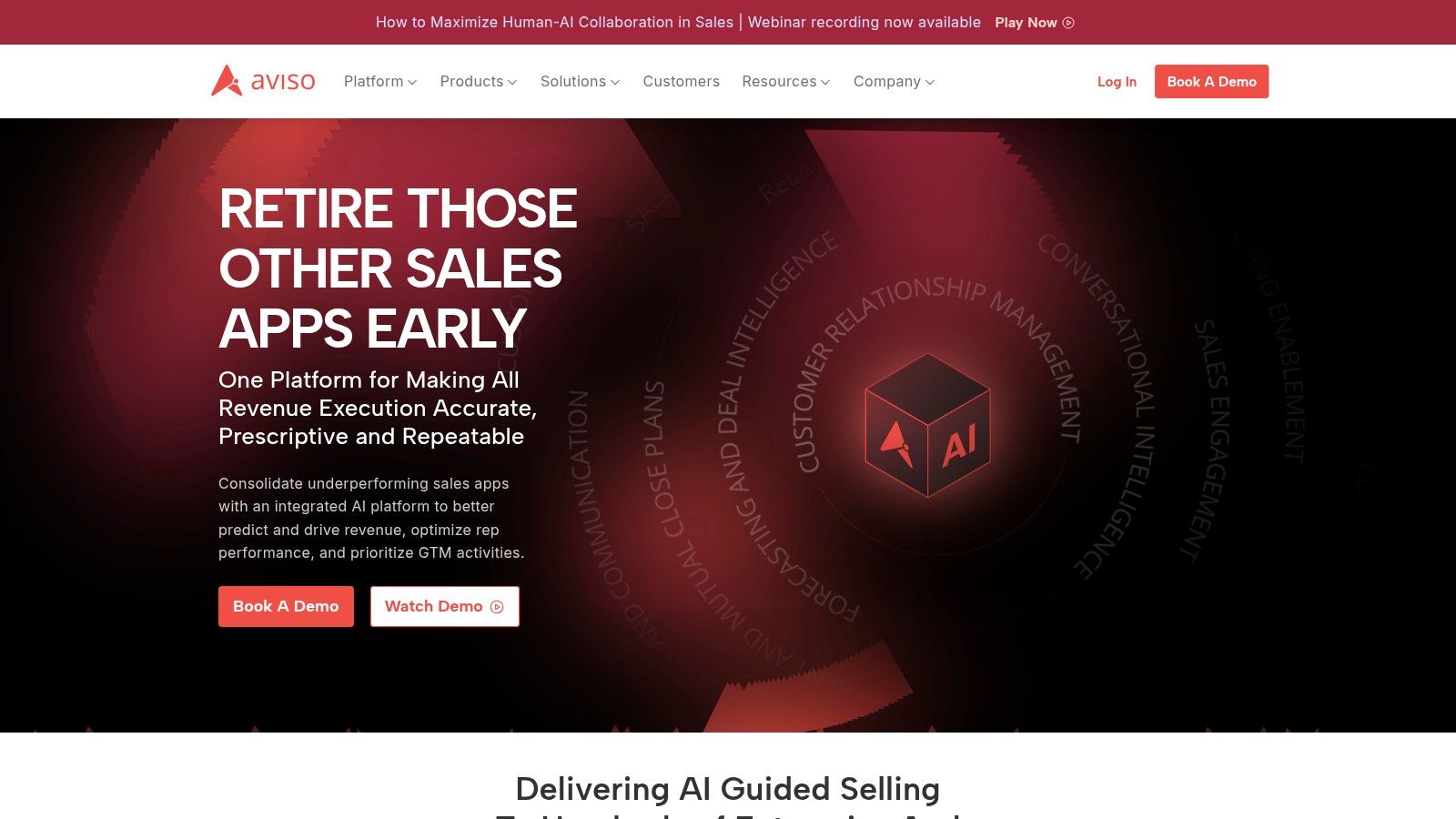
For TikTok Shop sellers and eCommerce entrepreneurs operating in the dynamic UK market, understanding future sales trends is crucial. Aviso's AI-driven win probability scoring provides a clear view of which deals are likely to close, enabling more effective resource allocation and targeted follow-up. Imagine knowing with a high degree of confidence which products are likely to be top performers in the coming weeks; this allows for optimised ad campaigns on TikTok and proactive inventory management to avoid stockouts. The deal intelligence feature, with its integrated risk identification, is invaluable for mitigating potential losses. By flagging potential issues early in the sales cycle, businesses can take corrective action and improve their chances of closing deals. This is particularly important for businesses dealing with fluctuating trends and viral product cycles often seen on platforms like TikTok.
While Aviso's robust features and proven accuracy make it a compelling choice, its premium pricing model might be a consideration, especially for smaller businesses or startups. Pricing isn't publicly available, so contacting Aviso directly for a tailored quote is necessary. Furthermore, the platform thrives on high-quality data. TikTok Shop sellers and eCommerce businesses need to ensure they have clean, well-maintained sales data history for Aviso to perform optimally. Implementation and setup may require some time and resources for full optimisation, and certain features may have a learning curve for new users. However, Aviso offers support and resources to help businesses integrate the platform effectively.
Compared to simpler forecasting tools that rely on basic spreadsheets or historical averages, Aviso provides a significant leap in accuracy and sophistication. For businesses that rely on data-driven insights, particularly those operating in the fast-paced world of TikTok Shop and eCommerce, Aviso's powerful AI and predictive capabilities offer a clear competitive advantage. This data-driven approach is especially relevant for the UK market where competition is fierce and staying ahead of the curve is essential.
Implementation Tips:
- Data Quality is Key: Ensure your existing CRM and sales data is clean, consistent, and readily accessible. A thorough data audit before implementation is highly recommended.
- Integrate with your CRM: Aviso integrates well with major CRM platforms. This seamless integration allows for a unified view of sales data and streamlines the forecasting process.
- Dedicate Time for Training: While Aviso's interface is designed for user-friendliness, allocating time for team training will ensure everyone can leverage the platform's full potential.
- Start with Key Metrics: Initially, focus on integrating and analysing a few key sales metrics. This allows for a more manageable implementation and helps teams gradually adapt to the new system.
Aviso's advanced features and AI-driven insights justify its place on this list. For businesses prioritising accurate sales forecasting, proactive risk management, and data-driven decision-making, especially within the UK's competitive eCommerce and TikTok Shop landscape, exploring Aviso is highly recommended. Visit their website at https://www.aviso.com/ to learn more.
8. Hubspot Sales Hub
HubSpot Sales Hub offers a valuable sales forecasting feature within its broader CRM platform, making it a compelling option, especially for growing businesses in the UK seeking an integrated solution. Its strength lies in its ease of use and seamless integration with other HubSpot hubs, allowing for streamlined workflows and efficient data management. This positions it as a solid choice for data-driven retailers, eCommerce entrepreneurs, TikTok Shop sellers, and digital marketing professionals who need reliable forecasting without the complexity of standalone, specialised tools. Imagine being able to anticipate demand for your trending TikTok product, adjust your ad spend accordingly, and manage all customer interactions within a single platform – HubSpot makes this possible.
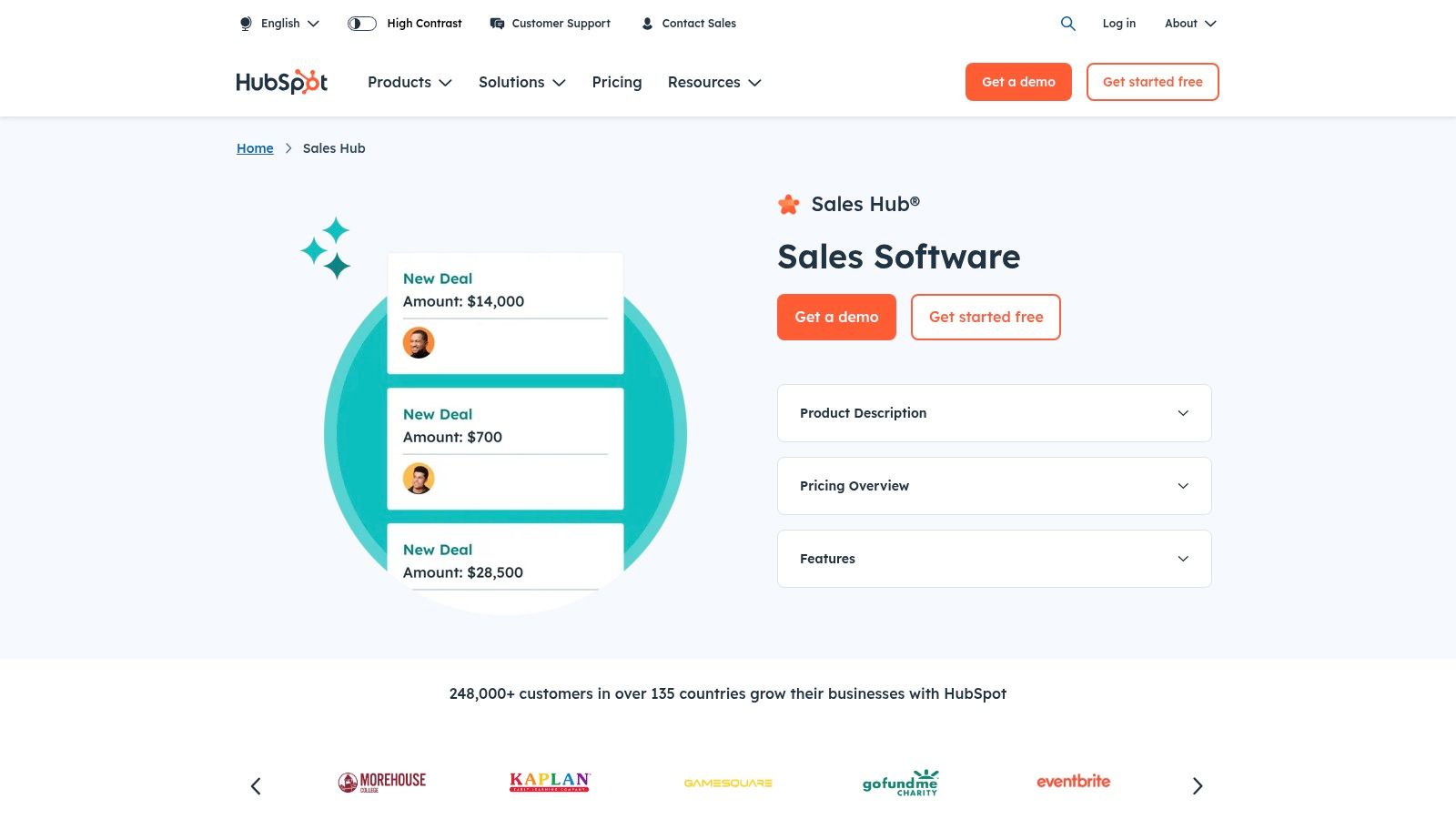
Specifically, HubSpot Sales Hub allows you to define custom forecasting categories relevant to your business. For instance, a TikTok Shop seller could categorise forecasts by product type (e.g., clothing, electronics, beauty products), sales channel (e.g., organic, paid advertising), or even influencer collaborations. This granular approach allows for more accurate predictions and better resource allocation. The platform then tracks deal progress through various stages, assigning probabilities to each stage to calculate weighted revenue forecasts. This helps eCommerce businesses and data-driven retailers on platforms like TikTok Shop understand the likelihood of closing deals and predict future income based on their current pipeline. The generated reports and dashboards provide valuable insights into projected revenue, allowing for proactive adjustments to sales strategies and marketing campaigns. For those interested in exploring HubSpot’s broader functionalities, you can learn more about Hubspot Sales Hub.
While pricing details can vary, HubSpot offers tiered pricing plans for its Sales Hub, making it accessible to small and mid-sized businesses. The free CRM provides basic sales tools, while the paid tiers unlock additional features like custom reporting and advanced analytics. Bear in mind that more advanced forecasting capabilities and AI-powered predictions are typically available in the higher-tier plans. This scalability allows businesses to start with a basic plan and upgrade as their needs evolve. In terms of technical requirements, HubSpot is a cloud-based platform, so there’s no need for extensive on-premise infrastructure. A stable internet connection and a web browser are typically sufficient for access.
Compared to specialized forecasting tools, HubSpot’s functionality might be considered less advanced. It lacks some of the sophisticated statistical modelling and predictive analytics found in dedicated solutions. However, for businesses primarily focused on improving sales processes within a unified CRM, HubSpot’s forecasting features offer a strong starting point. This is particularly advantageous for early adoption beta testers and eCommerce entrepreneurs who value the platform's integrated approach to marketing, sales, and customer service.
Implementing HubSpot Sales Hub for sales forecasting is generally straightforward. The intuitive user interface requires minimal training, allowing teams to quickly get up to speed. The seamless integration with HubSpot Marketing and Service Hubs further simplifies setup and data migration for existing HubSpot users. A key implementation tip is to carefully define your custom forecasting categories and deal stages to ensure accurate and meaningful projections. This initial setup is crucial for leveraging the platform's forecasting capabilities effectively. Clearly defined stages aligned with your specific sales process will yield the most reliable insights. For example, a TikTok Shop seller might use stages like "Prospecting Influencers," "Content Creation," "Campaign Launch," and "Sales Conversion" to track their deals and generate accurate forecasts. This allows for more precise revenue projections and proactive adjustments to marketing strategies.
9. Gong Revenue Intelligence
Gong Revenue Intelligence takes a novel approach to sales forecasting by analysing the actual conversations happening between your sales team and potential customers. Instead of relying solely on subjective estimations or CRM data, Gong leverages conversation intelligence to provide a reality-based forecast. This is particularly valuable for data-driven retailers, eCommerce entrepreneurs, and TikTok Shop sellers in the UK who need accurate predictions to manage inventory, plan marketing campaigns, and ultimately, boost profitability. By understanding the nuances within sales interactions, businesses can anticipate potential roadblocks and capitalise on emerging opportunities.
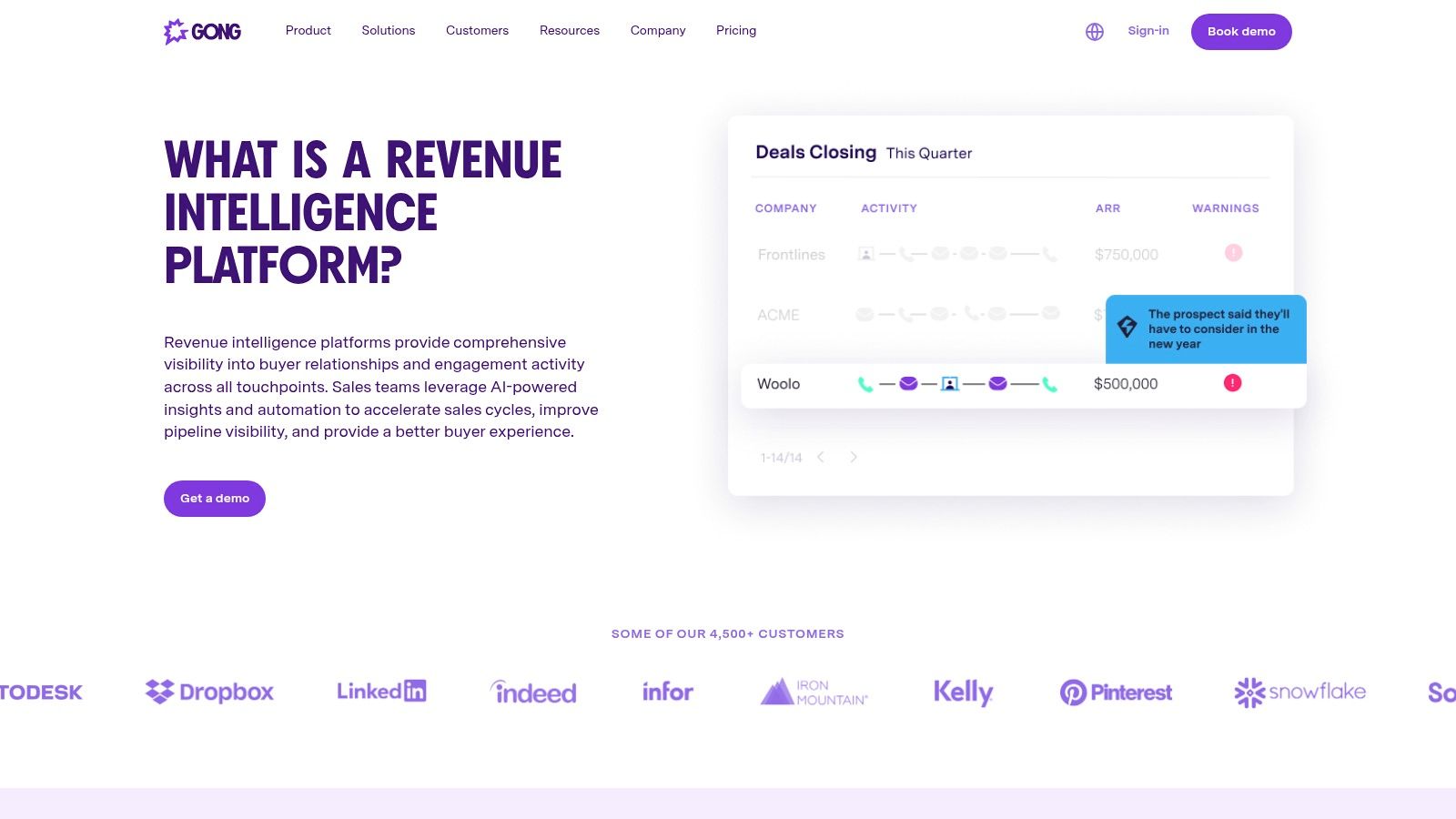
Gong achieves this by recording, transcribing, and analysing sales calls, emails, and other meeting interactions. It then identifies patterns and keywords that correlate with successful deals, stalled negotiations, or lost opportunities. For example, it might detect that specific objections raised early in the sales cycle frequently lead to deal closures, or that a lack of engagement from key decision-makers often signals a lost sale. This allows sales leaders to spot risks in forecasted deals that traditional methods might miss and provides actionable insights to improve forecast accuracy.
Features and Benefits:
- Conversation Intelligence: Gain insights from actual customer interactions to understand buyer sentiment and identify potential roadblocks or opportunities.
- Deal Risk Analysis: Gong uses communication patterns to flag potential deal risks, enabling proactive intervention and improved win rates.
- Pipeline Movement Tracking and Alerts: Monitor deal progression and receive alerts when deals stall or accelerate, allowing for timely adjustments to sales strategies.
- Reality-Based Forecasting: Base forecasts on real customer interactions rather than subjective opinions or incomplete CRM data.
- Coaching Insights: Use conversation data to identify areas for sales team improvement and provide targeted coaching to boost performance.
Pros:
- Unique approach: Leveraging conversation data provides a level of insight unavailable with traditional forecasting methods.
- Identifies hidden risks: Uncovers potential deal risks that other systems miss by analysing the subtleties of customer communication.
- Contextualized insights: Provides context behind the numbers with actual customer feedback, enabling data-driven decision-making.
- Strong CRM integrations: Integrates seamlessly with major CRM systems for efficient data flow and reporting.
Cons:
- Premium pricing: Gong's robust features come with a premium price tag, making it more suitable for larger businesses or those with significant sales operations. Pricing is not publicly available and requires contacting their sales team.
- Focus on conversation intelligence: While powerful, the focus on conversation intelligence might not suit businesses relying solely on traditional forecasting methods.
- Requires team adoption: Successful implementation hinges on active adoption by the sales team, particularly regarding call recording.
- Data dependency: Achieving optimal results requires historical data accumulation, so it may take time to see the full benefits.
Implementation and Setup Tips:
- Integrate with CRM: Connect Gong to your CRM system to streamline data flow and ensure accurate reporting.
- Define key metrics: Clearly define the key metrics you want to track and analyse to get the most relevant insights.
- Train your sales team: Ensure your sales team understands the value of call recording and actively participates in the process.
- Review data regularly: Regularly review the data and insights provided by Gong to identify trends and adjust sales strategies accordingly.
Comparison with Similar Tools:
While some CRM systems offer basic forecasting features, Gong differentiates itself with its focus on conversation intelligence. Tools like Chorus.ai and Salesloft offer similar functionalities, but Gong stands out with its advanced analytics and deeper integration with CRM systems.
Why Gong Deserves its Place on this List:
Gong's unique approach to sales forecasting makes it a valuable tool for data-driven businesses, especially those operating within the fast-paced world of eCommerce and TikTok Shops. Its ability to analyse actual customer interactions provides a level of insight that traditional methods simply cannot match. For UK-based businesses seeking to improve sales forecast accuracy and gain a competitive edge, Gong Revenue Intelligence is a powerful solution worth considering. Visit their website for more information.
10. Pipedrive
Pipedrive is a strong contender for UK-based TikTok Shop sellers, eCommerce entrepreneurs, and digital marketing professionals looking for accessible sales forecasting within a user-friendly CRM. Its emphasis on simplicity and visual pipeline management makes it particularly attractive for small to medium-sized businesses dipping their toes into forecasting or those who find dedicated forecasting tools overly complex. For those already familiar with Pipedrive’s CRM, integrating its forecasting features is seamless. This makes it an excellent choice for businesses prioritising ease of use and quick implementation over highly granular, AI-powered predictions. Its affordability also makes it a good entry point for smaller e-commerce operations or those testing and scaling on platforms like TikTok Shop.
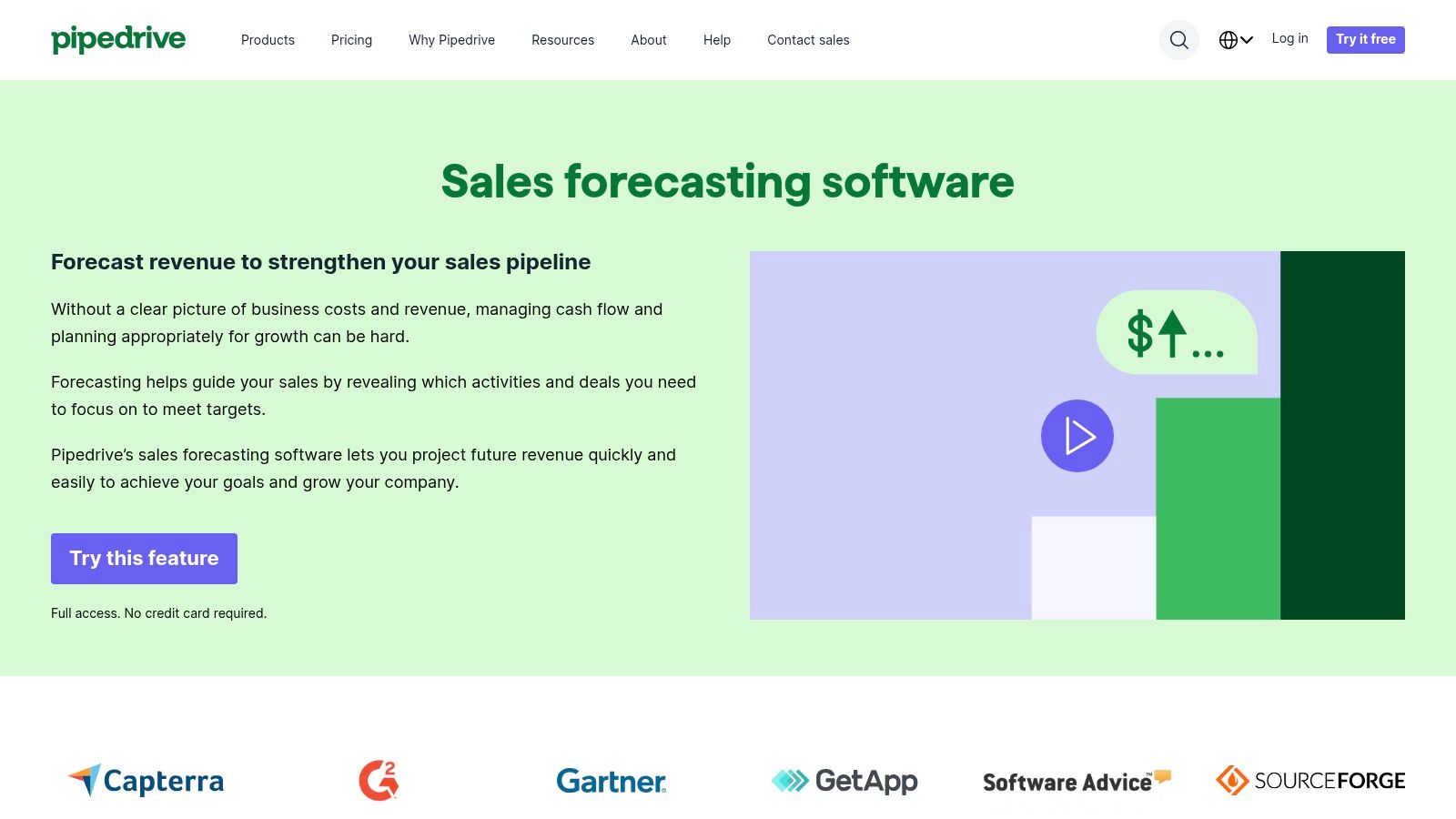
Pipedrive's visual pipeline forecasting allows you to see deal progress at a glance. By customising deal stages and assigning probabilities, you can generate weighted forecasts, offering a more realistic revenue projection. For example, a TikTok Shop seller could define stages like "Lead Generated," "Product Demoed," "Order Placed," and "Payment Received," each with increasing probability. This allows for more accurate revenue predictions based on the likelihood of closing deals at each stage. Dashboards and reports further facilitate tracking progress against set goals, which is invaluable for data-driven retailers and early adoption beta testers constantly evaluating campaign effectiveness.
While Pipedrive doesn’t offer the depth of dedicated forecasting solutions like, say, Aviso or Clari (which would suit larger enterprises with intricate sales processes), its activity-based selling methodology is a bonus for TikTok Shop sellers and e-commerce entrepreneurs needing to track and optimise interactions across different marketing channels. This can be particularly relevant for managing influencer marketing campaigns or tracking conversions from specific TikTok ads.
Pricing: Pipedrive offers various pricing tiers starting from £12.50 per user per month (billed annually). Check their website for the latest pricing and available features within each tier.
Technical Requirements: Pipedrive is cloud-based, requiring only an internet connection and a web browser. They also offer a robust mobile application, facilitating on-the-go access to forecasts and sales data – a significant advantage for busy eCommerce entrepreneurs.
Implementation Tips:
- Define Clear Deal Stages: Carefully map out your sales process on TikTok Shop (or whichever platform you're using) and translate that into distinct stages within Pipedrive. Be specific and ensure the stages reflect your actual workflow.
- Set Realistic Probabilities: Don't inflate probabilities. Base them on historical data or realistic estimations. The more accurate your probabilities, the more reliable your forecasts.
- Integrate with Other Tools: Explore Pipedrive’s integrations with other platforms you’re using, particularly your e-commerce platform and marketing automation tools. This provides a holistic view of your sales and marketing efforts.
- Utilise Reporting: Regularly review the dashboards and revenue forecasting reports. Identify trends, spot potential roadblocks, and adjust your strategies accordingly.
Pros:
- Intuitive interface and easy setup
- Affordable pricing, especially for smaller businesses
- Strong mobile application for access on the go
- Good customization options for deal stages and probabilities
Cons:
- Limited advanced forecasting functionalities
- Minimal AI and predictive analytics capabilities
- Less suitable for complex enterprise needs with multiple sales teams and intricate pipelines
- Reporting features, while adequate for basic needs, are less robust than specialised forecasting tools
Website: https://www.pipedrive.com/en/features/sales-forecasting
Pipedrive’s intuitive sales forecasting features within a familiar CRM context offer an excellent starting point for UK-based e-commerce businesses, particularly those operating on rapidly evolving platforms like TikTok Shop. Its accessibility and affordability make it a valuable tool for data-driven decision-making without the complexity of more advanced, enterprise-grade solutions.
Top 10 Sales Forecasting Software: Feature Comparison
| Platform | Key Features ✨ | User Experience ★ | Value Proposition 💰 | Target Audience 👥 |
|---|---|---|---|---|
| Salesforce Sales Cloud | AI-powered Einstein, custom models, real-time collaboration | Robust but complex | Enterprise-grade; premium pricing | Large enterprises and complex sales teams |
| InsightSquared | AI-driven analytics, interactive visualizations, deal-by-deal analysis | User-friendly | Powerful insights with higher cost | Mid-to-large sales organizations |
| Anaplan | Multi-dimensional forecasting, scenario planning, connected planning | Scalable yet steep learning curve | Enterprise planning with advanced modeling; higher expense | Large enterprises with complex needs |
| Clari | AI risk assessment, pipeline inspection, transaction analytics | Intuitive with excellent mobile support | Precise predictions; premium pricing | Growing sales teams and enterprises |
| NetSuite Planning & Budgeting | Driver-based forecasting, scenario modeling, variance analysis | Robust financial modeling; complex UI | Integrated with NetSuite ERP; higher total cost | Established enterprises using NetSuite ERP |
| Zoho CRM | Zia AI assistant, multiple forecasting methods, custom forecast tracking | Simple and cost-effective | Affordable CRM with essential forecasting | Small to medium businesses |
| Aviso | AI win probability, guided selling, conversation intelligence | Highly accurate with a learning curve | Premium model delivering actionable guidance | Enterprise-level sales teams |
| HubSpot Sales Hub | Custom forecasting, pipeline visualization, deal stage tracking | Intuitive and easy-to-use | Affordable entry with regular updates | SMBs and mid-sized companies |
| Gong Revenue Intelligence | Conversation intelligence, deal risk insights, coaching insights | Data-rich and unique approach | Deep insights with premium pricing | Data-driven sales teams |
| Pipedrive | Visual pipeline forecasting, weighted deal stages, activity-based insights | Highly intuitive and simple | Affordable and straightforward | Small-to-medium sales teams |
Choosing the Right Sales Forecasting Software for Your Business
From established platforms like Salesforce Sales Cloud and NetSuite Planning and Budgeting to agile solutions like Pipedrive and Zoho CRM, the options for sales forecasting software are diverse. This list offers a solid starting point for UK-based TikTok Shop sellers, eCommerce entrepreneurs, and digital marketing professionals seeking to enhance their revenue prediction capabilities. Key takeaways include the importance of aligning software features with your specific business needs, considering scalability for future growth, and ensuring seamless integration with your existing technology stack. Remember that factors like budget, ease of use, and the level of support offered by the vendor are also crucial considerations. For instance, if you’re managing a growing product catalogue across multiple platforms, especially fast-paced environments like TikTok, efficient product descriptions are key. For businesses looking to streamline the process of creating compelling product descriptions, leveraging AI-powered tools can be a game-changer. Explore the capabilities of AI product description generators to enhance your product listings and potentially boost sales, as discussed in AI Product Description Generator — Boost E-commerce Sales from DescriptionLab.
Implementing a new sales forecasting tool requires careful planning. Start with a clear understanding of your objectives and identify the key metrics you want to track. Involve your sales team in the selection process to ensure buy-in and smooth adoption. Don’t hesitate to take advantage of free trials and demos to test different platforms and find the best fit for your workflow. For specialised needs like profit tracking and cost forecasting for TikTok and future Amazon selling, consider exploring solutions that offer more granular insights into platform-specific expenses.
Accurate sales forecasting is the cornerstone of informed business decisions. Choosing the right software empowers you to proactively manage your pipeline, optimize resource allocation, and drive sustainable growth. Ready to take your profit tracking and cost forecasting for your TikTok Shop to the next level? Explore Mergoio, a specialized solution designed to complement your chosen sales forecasting platform and provide deeper insights into your eCommerce performance.

Leave a Reply